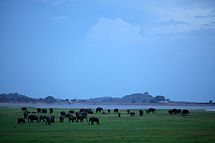User:Nandika dilan/sandbox
This article has multiple issues. Please help improve it or discuss these issues on the talk page. (Learn how and when to remove these messages)
|
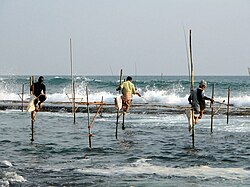
Tourism in Sri Lanka is growing rapidly. For centuries, Sri Lanka has been a popular place of attraction for foreign travelers. The famous Chinese traveler Fa-Hien arrived in Sri Lanka in the late 4th century. In the twelfth century, Italian explorer Marco Polo claimed that Sri Lanka to be the best island of its size in the world.[1][2] In view of its fascinating scenic beauty and rich cultural heritage, Sri Lanka has been held among the foreign travelers continues up to the present as a one of best tourist destinations in the world.
In 2012, post office worldwide holiday costs barometer named Sri Lanka as the best valued destination for holidays[3] and also in 2013 the popular travel guide book Lonely Planet named Sri Lanka as the best travel destination for 2013.[4] According to the Travel and Tourism Competitiveness Report 2015 Sri Lanka is at 63 out of 141 countries.[5]
Tourism planning & development
[edit]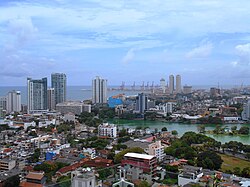

The government initiatives in development of tourism date back to 1937 when the Ceylon Tourist Bureau was established.[7] But it was closed down in September 1939 as the impact of World War II. After the Independence the promotion of tourism was again considered by re-establishing the Ceylon Tourist Board which took over the function of the Tourist Bureau. More formal recognition for country's tourism sector was given with the enactment of Act No.10 of 1966.[8] Which provided the legislation for the establishment of Ceylon Tourist Board. Since then the Ceylon Tourist Board functioned as the state agency, responsible for development and promotion of the tourism sector in Sri Lanka.
In October 2007 according to the Section 2 of the Tourism Act No. 38 of 2005, the Sri Lanka Tourist Board (Act No 10 of 1966) was replaced by Sri Lanka Tourism Development Authority (SLTDA).[9]
Currently Sri Lanka Tourism Development Authority has classified Sri Lanka into several resort regions suitable for tourism development.[10]
- Colombo and Greater Colombo Resort Region: The Colombo and Greater Colombo Resort Region spreads along the Mount Lavinia in south to Negambo in the north. Colombo city is the main part of the zone and it is the center for business activities, conferences and sport events in the country. Colombo also serve as both a gateway and stopover point for international tourist.
- South Coast Resort Region: The south coast zone extends from Wadduwa to Tissamaharama. The zone has been divided in to two main region. The first region extends from Wadduwa to Galle. Coastal areas like Kalutara, Beruwala, Bentota, Dedduwa, Madu Ganga, Balapitiya, Ahungalla, and Hikkaduwa are included for this region. The second region, extending from Galle to Tissamaharama includes Unawatuna, Koggala, Weligama, Mirissa, Matara, Tangalle and Hambantota areas as sub points of the zone.
- East Coast Resort Region: The East Coast Resort Region extends from Kuchchaveli in the north to Pottuvil in the south. The main tourism zones in this region are Arugam Bay, Pasikudah, Trincomalee and Nilaveli.
- West Coast Resort Region: The West Coast Resort Region extends along Kalpitiya, Marawila and Waikkala areas.
- High Country Resort Region: Nuwara Eliya, Bandarawela and Maskeliya are included for High Country Resort Region.
- Ancient Cities Resort Region: This region has five world heritage sites, namely Anuradhapura, Dambulla, Kandy, Polonnaruwa and Sigiriya. Other regions include Habarana, Giritale, Matale and Victoria.
Tourist arrivals
[edit]When the government decided to develop the tourism sector as a separate sector of country's economy by establishing the Ceylon Tourist Bureau in 1966, there were 18,969 foreign tourist arrivals in Sri Lanka. Since then there was a upward trend of tourist arrivals until 1982, with a exception of 1971. Between 1976 and 1982, the tourist arrivals had increased 24% per year. The tourist traffic in 1982 showed that there was a remarkable growth in number of tourists with 407,230 arrivals.[11] However with the beginning of the civil war in 1983, the growth of the tourist arrival was declined and stagnated to around 300,000 - 500,000 arrivals annually.
The Civil War that had longed over 25 years was ended in 2009 as LTTE separatist were defeated by the government forces. In 2009 the tourist arrivals accounted for 448,000 and in 2015, it was 1,798,380, showing over 300 percent growth in six years.[12]
| Rank | Country | Number |
|---|---|---|
| 1 | 356,729 | |
| 2 | 271,577 | |
| 3 | 188,159 | |
| 4 | 133,275 | |
| 5 | 96,440 | |
| 6 | 95,167 | |
| 7 | 74,496 | |
| 8 | 58,176 | |
| 9 | 54,254 | |
| 10 | 44,122 | |
| Total foreign | 2,050,832 |

Domestic tourism
[edit]There is a significant domestic tourist segment and excursions in Sri Lanka. In 2014 six million Sri Lankans had traveled within the country as domestic tourists.[14] The main purposes of travel by the domestic tourists are pilgrimage, family holiday, study works, and sight seeing. The main destinations of domestic tourists are Anuradhapura, Kataragama, Nuwara Eliya, Kandy, Sri Pada, Polonnaruwa, Sigiriya and Dambulla. Domestic tourism is noticeable during school vacations and on weekends.
Attractions
[edit]The tourism attractions are classifiable into natural and anthropogenic. Natural attractions include places of nature spots, flora and fauna, and places with a pleasant climate. Geotourism sites may also be included for this category. Anthropogenic attractions include archaeological and cultural attractions, historical and religion sites, performing arts and folklore, handicrafts and artefacts.
Wildlife
[edit]Despite its small size, Sri Lanka possess high level of biodiversity and wildlife resources and it is rated among the 34 Biodiversity hotspots in the world.[19] From flora to fauna, a lot of species are indigenous to Sri Lanka. That has made the island as a country with highest rates of biological endemism in the world.
In Sri Lanka 13% of its land surface has been designated as Wildlife Protected Areas (WLPAs) which at present exceeds a total area of 8500 km2.[20] Approximately 7% of the area are comprised with National Parks, the areas allowed for the public to see and study wildlife. Hence that Sri Lanka's National Parks have been become popular tourist destinations in the country.
|
National Parks |
Beaches
[edit]
Sri Lanka possess nearly 1600 km coastlines with popular tropical beaches among both local and foreign tourists.[23] Most of the coastlines of the country are studded with varying coastal features such as bays, lagoons, sandbanks, and rocky headlands. Marine recreation activities, such as sea bathing and swimming, surfing, boating, snorkelling, deep-sea fishing, underwater photography, and scuba diving, can be seen at most of these beaches and related resort areas. Beaches at Tangalle, Beruwala, Mirissa, Bentota, Unawatuna Arugam Bay, Pasikudah, Uppuveli and Negombo are considered as famous tourist beaches in the country.
|
Related attractions |
Natural Scenic Beauty
[edit]Sri Lanka has numerous tourist attractions with areas of natural scenic beauty, primarily including beautiful mountainous terrains, agricultural landscapes, waterfalls, places with diverse climatic conditions, reservoirs (Wewas), rivers and various other places.
|
Related attractions |
Botanical/Zoological Gardens
[edit]
The country has six botanical gardens and four Zoological gardens. The botanical gardens are maintained by the Department of National Botanical Gardens.[24] and the zoological gardens are maintained by the Department of National Zoological Gardens.[25] The gardens have become attractive places among local and foreign visitors.
|
Zoological Gardens |
Heritage
[edit]
Heritage tourism involves visiting historical sites. Sri Lanka is very rich in pre-historic, proto-historic, and historic monuments, which bespeak its ancient civilization and culture. Mainly Buddhism has influenced in moulding cultural heritage of the country. The historic period of Sri Lanka proper starts at circa 236 B.C. with the introduction of Buddhism to the country by the missionaries sent by the Indian empire Asoka.
The UNESCO has declared six archaeological and two ecological World Heritage Sites in the country.[27] Beside the world heritage sites the government of Sri Lanka has declared number of archaeological protected sites and monuments with in the country.
|
World Heritage Sites |
Pilgrimage
[edit]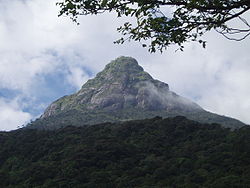
Sri Lanka is well known for its rich Buddhist culture as well as other religions. Being a religious country, Sri Lanka has many places with religious and historic significance, which attracts tourists from all over the world. Anuradhapura, Temple of the Tooth, Sri Pada, Shrine of Our Lady of Madhu and Kataragama, are few of famous religious sites in the island that attract a large number of tourists.
The foot Pilgrimage called Pada Yatra, which is one of the Sri Lanka's oldest traditions, has been practiced for centuries, where the local people from Jaffna come along the East Coast to Kataragama shrine.[29]
|
Related attractions |
Sports and Adventure
[edit]Sports tourism is defined as either people been involved, observing or participating in a particular sporting event for leisure.[30] Sri Lanka is also a destination for some of sports such as cricket, rugby, golf and surfing. Except for the cricket, the contribution to the tourism sector from other sports are still in very low level. Apart from mainstream sports events, adventure sports are also included as a part of the sports tourism. Trekking, hiking, diving, rock climbing, deep sea fishing, whale watching and hot air ballooning are some of the adventure sports those can be found in Sri Lanka.[31]
|
Related attractions |
Culture and other
[edit]

Cultural Tourism is an another category of tourism in Sri Lanka. It includes tourism in urban areas, particularly historic or large cities and their cultural facilities such as museums and theatres.
Museums and Theatres - Currently four national museums[33] and 26 archaeological museums[34] have been established in Sri Lanka. National museums are maintained by the Department of National Museums and archaeological museums by the Archaeological department. Beside the museums a large number of theatres also can be found in Sri Lanka.
Festivals - Sri Lanka is a multi-cultural country with several different festivals celebrated by various communities. Sinhala and Tamil New Year Celebrations, Vesak Festival, Christmas, Ramadan festival, Thai Pongal , Galle Literary Festival are few of major festivals celebrating in Sri Lanka.
Performing arts - There are three main traditional dance forms in Sri Lanka: Kandyan Dancing, Low Country Dancing, and Sabaragamuwa Dancing. Though not unique to Sri Lanka 'Bharatanatyam' which originated from India is also popular in Sri Lanka particularly among the Tamil community.
Food - The cuisine of Sri Lanka has been influenced by many historical, cultural, and other factors. Rice is the main staple diet of the country. Other staples include hoppers, string hoppers, pittu etc.
Being one of the largest producers of tea in the world Sri Lanka is best known for the production of unorthodox tea. Tea was introduced to the country by the British who called the country “Ceylon”. Pure “Ceylon Tea” is considered some of the finest tea produced anywhere in the world.
Handicrafts - Different types of handicrafts are available in Sri Lanka; including Wood carving, Silverware, Brass castings, Ceramic ware, Bamboo products, Pottery, Batiks, Lace works, Cane works, Costume jewelry, Lacquerware, Wooden masks, Coir goods, Handlooms, Ivory products.
|
Relate atrractions |
Accommodations
[edit]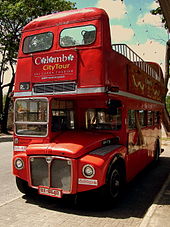

Tourist accommodation in Sri Lanka consist of graded hotels, supplementary establishments, guest houses and limited scale camping sites. More informal accommodation is available on a paying guest system in private houses and hill-country tea estate bungalows.
Earnings
[edit]The tourist industry is making a significant contribution to the national economy by directly contributing to the government budget, foreign-exchange earnings and employment generation. It generates both direct and indirect, in the provision of goods and services to the tourist sector.
Social and environmental impacts
[edit]Tourism in Sri Lanka, despite its benefits for the local economy (it is one of the main foreign income sources of the country), is undergoing several critics. Thus, some studies indicate that a quick modern tourism development would not cater to the specific needs of the local people.[35] Also, the high biodiversity of Sri Lanka seems to be threatened by the development of mass tourism which has already affected several natural reserves. Some endangered animal species seem to be seriously threatened by the rise of tourism in some areas: that is the case of the Keerthisinghe’s Rock Frog, which is endemic in Sri Lanka.[36]
An alternative kind of tourism - called Ecotourism, sustainable tourism or responsible tourism - enables travelers to do tourism throughout Sri Lanka while contributing on the well-being of the local communities and making sure the environmental impact is limited.[37] The Sri Lanka Ecotourism Foundation is the national organization that created an official ecotourism network through the island, allowing to develop sustainable tourism with wide options of travel. In 2010, the foundation won the presidential awards for "Outstanding Contribution for Tourism in Sri Lanka".[38]
See also
[edit]- Economy of Sri Lanka
- Travel and Tourism Competitiveness Report
- Visa policy of Sri Lanka
- World Tourism Organization
- World Travel Monitor
References
[edit]- ^ "Sri Lanka - Facts". Retrieved 5 November 2016.
- ^ "Sri Lanka: an island paradise". The Times. 27 October 2012. Retrieved 5 November 2016.
- ^ "Holiday Costs Barometer 2012" (PDF).
- ^ "Best in Travel 2013 - Top 10 countries". Lonely Planet. Retrieved 5 November 2016.
- ^ "Travel and Tourism Competitiveness Report 2015 - Sri Lanka". weforum.org. Retrieved 5 November 2016.
- ^ "10 most popular cities for travelers in 2015". CNN. Retrieved 6 November 2016.
- ^ "Overview". Sri Lanka Tourism Development Authority. Retrieved 9 November 2016.
- ^ "History at SLTDA". Sri Lanka Tourism Development Authority. Retrieved 5 November 2016.
- ^ "Sri Lanka Tourism Development Authority". Sri Lanka Tourism Development Authority. Retrieved 5 November 2016.
- ^ "Key Development Projects". Sri Lanka Tourism Development Authority. Retrieved 6 November 2016.
- ^ "Overview of Tourism Industry In Sri Lanka". Sri Lanka Tourism Development Authority. Retrieved 9 November 2016.
- ^ "Post-civil war, Sri Lanka's tourism industry having one great run". The Hindu. 30 April 2016. Retrieved 9 November 2016.
- ^ TOURIST ARRIVALS BY COUNTRY OF RESIDENCE 2016
- ^ "Six million tourists travel within Sri Lanka". The Sunday Times. 14 December 2014. Retrieved 9 November 2016.
- ^ "Yala's giant leopards". BBC. 13 October 2014. Retrieved 12 November 2016.
- ^ "Minneriya National Park". www.yamu.lk. Retrieved 12 November 2016.
- ^ "The Gathering: Sri Lanka's great elephant migration". CNN. 3 October 2014. Retrieved 12 November 2016.
- ^ "'Spectacular' coverage for The Gathering". The Sunday Times (Sri Lanka). 17 July 2011. Retrieved 12 November 2016.
- ^ "Wildlife tourism in Sri Lanka". www.ft.lk. 12 September 2012. Retrieved 12 November 2016.
- ^ "Overview". Department of Wildlife Conservation. Retrieved 12 November 2016.
- ^ "Could Unawatuna enter the record books as the World's Best Beach once again?". www.news.lk. Retrieved 12 November 2016.
- ^ "World's 100 best beaches#Unawatuna, Sri Lanka". CNN. 28 May 2013. Retrieved 12 November 2016.
- ^ "Pristine". www.srilanka.travel. Retrieved 12 November 2016.
- ^ "Department of National Botanical Gardens". Ministry of sustainable development and wildlife. Retrieved 12 November 2016.
- ^ "Department of National Zoological Gardens". Government Information Center. Retrieved 12 November 2016.
- ^ "Eighth wonder of the world ?". www.news.lk. 17 January 1999. Retrieved 13 November 2016.
- ^ "Cultural Heritage". www.srilanka.travel. Retrieved 13 November 2016.
- ^ "Sri Pada Mountain (Adams Peak) – ශ්රී පාදය (සමනල කන්ද)". Amazing Lanka. Retrieved 13 November 2016.
- ^ "Pilgrimage". www.srilanka.travel. Retrieved 13 November 2016.
- ^ "Sports Tourism is worth $600 billion and Sri Lanka enters with Golf and Surfing". www.news.lk. 18 August 2015. Retrieved 13 November 2016.
- ^ "Adventure Sports". www.srilanka.travel. Retrieved 13 November 2016.
- ^ "Promoting tea tourism". Sunday Observer (Sri Lanka). 26 September 2010. Retrieved 14 November 2016.
- ^ "Department of National Museums". Department of National Museums. Retrieved 14 November 2016.
- ^ "Museums". Department of Archaeology. Retrieved 14 November 2016.
- ^ Evan Due (1980). "Tourism and Development: Examining the Case of Sri Lanka". Open Access Dissertations and Theses.
- ^ Gazala Anver. "Tourism Threatening Endangered Species". The Sunday Leader.
- ^ J. Thumira Gunasena. "Tourism in Sri Lanka and its Impact on Social Political and Natural Environment" (PDF).
{{cite journal}}: Cite journal requires|journal=(help) - ^ "SRI LANKA ECOTOURISM FOUNDATION".
External links
[edit]- Sri Lanka Tourism — Official government tourism website.


